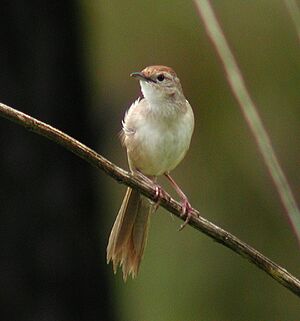Tawny grassbird facts for kids
Quick facts for kids Tawny grassbird |
|
|---|---|
 |
|
| In Samsonvale, SE Queensland, Australia | |
| Conservation status | |
| Scientific classification | |
| Genus: |
Cincloramphus
|
| Species: |
timoriensis
|
| Synonyms | |
|
Megalurus timoriensis |
|
The tawny grassbird (Cincloramphus timoriensis) is a type of large songbird. It belongs to a bird family called Locustellidae, which includes grass- and bush-warblers. These birds often live in grassy areas and places with reeds.
The tawny grassbird has streaks on its back. It has a special rich brown cap on its head. Its belly is lighter in color, and it has a long tail that gets narrower at the end. These birds often make loud, grumpy "churring" sounds. They also have a longer call that starts with "tick-tick-tick-tick" and ends with a loud, fast trill. There are 10 different types, or subspecies, of the tawny grassbird. You can find them in Australia, Indonesia, Papua New Guinea, and the Philippines.
Contents
About the Tawny Grassbird
Scientists group living things into families. The tawny grassbird is in the Locustellidae family. This name was given by a scientist named Bonaparte in 1854. The word "grassbird" was used in the 1800s. It helps us know that these birds like to live in tall grass.
The tawny grassbird has had a few other names over time. Some of these include tawny sphenoeacus and rufous-capped marshbird. In Asia, people often call it a grass-warbler. Studies of their genes show that they are closely related to birds called songlarks.
There are 10 known types of tawny grassbirds. Each type is called a subspecies:
- Cincloramphus timoriensis timoriensis (found in Timor, Lesser Sundas)
- Cincloramphus timoriensis tweeddalei (found in northern and central Philippines)
- Cincloramphus timoriensis alopex (found in Bohol, Leyte, and Cebu, central Philippines)
- Cincloramphus timoriensis amboinensis (found in Ambon, southern Moluccas)
- Cincloramphus timoriensis crex (found in southern Philippines)
- Cincloramphus timoriensis mindorensis (found in Mindoro, northwestern Philippines)
- Cincloramphus timoriensis celebensis (found in Sulawesi)
- Cincloramphus timoriensis inquirendus (found in Sumba, Lesser Sundas)
- Cincloramphus timoriensis muscalis (found in southern New Guinea)
- Cincloramphus timoriensis alisteri (found in northern and eastern Australia)
The Cincloramphus timoriensis alisteri subspecies is even divided into two groups. One lives in Eastern Australia and the other in Northern Australia.
Most scientists agree on the family name Locustellidae. However, some think the tawny grassbird belongs to the Sylviidae family. Also, while Cincloramphus is the usual genus name, megalurus is sometimes used.
What the Tawny Grassbird Looks Like
The tawny grassbird is a medium-sized bird. Its wingspan is about 56 to 69 millimeters. Its strong beak is about 14 to 17 millimeters long. It weighs around 13 to 25 grams.
This bird has a rich brown cap on its head with no streaks. Its flight feathers have clear brown edges when the wing is folded. The underside of its body has no streaks at all. It also has a long, drooping tail and a brown rump (the area above its tail).
Male tawny grassbirds have a varied song. They sing while flying to attract mates or from high spots. Males sing mostly in spring and summer.
You can tell the tawny grassbird apart from the little grassbird. The tawny grassbird is bigger. It has a stronger beak, more brown feathers, and a longer tail.
Where Tawny Grassbirds Live
In Australia, tawny grassbirds mostly live in "coastal lowlands." They like areas with tall grasses, sedges, and reeds. They also live near wetlands. In 2011, a group of tawny grassbirds was found in Alice Springs. This was almost 100 kilometers away from other known groups. Usually, the grassbirds found inland in Eastern Australia are little grassbirds.
Behaviour
Feeding Habits
Tawny grassbirds eat insects.
How They Communicate
The Slater Field Guide to Australian Birds says their voice is a rich "ch-ch-ch-zzzzzzt lik lik." They also make a loud "see-lick" sound and a high-pitched trill that goes down in tone. When flying, they make a "metallic chuck chuck chuck" sound. The Australian Bird Guide says displaying males have a "delightful varied song." This song is heard during their display flights and from high places. Their alarm call is a repeated harsh "tjik" or "jk-jk."
Reproduction
Tawny grassbirds build their nests in tall grass. Their nests are shaped like cups and are well hidden. They usually lay three reddish eggs with freckles on them.
Protecting Tawny Grassbirds
The tawny grassbird is listed as "Least Concern" (LC). This means scientists are not very worried about them right now. They live in a large area, and their numbers seem to be steady. Even though we don't know the exact number of birds, it's not thought to be dangerously low.
Some people worry that their numbers might go down. This is because tall grasses, where they like to live, are sometimes eaten by grazing animals. However, in New Guinea, more tawny grassbirds were found in shorter, grazed grass than in taller grasses nearby.


